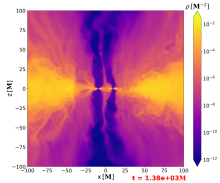
Description
Accreting supermassive binary black holes are promising multimessenger sources because they strongly emit both gravitational wave (GW) and electromagnetic (EM) radiation. It is the goal of this project to combine astrophysical knowledge about the environments of these sources with detailed physical simulations of gas flows in the immediate neighborhoods of these binaries, and explicit computation of the time-dependent spacetime in which the gas is placed, in order to predict the signals observers would see to identify them.
Our proposed network, comprising experts in the fields of theoretical and computational astrophysics, will provide observable predictions of supermassive black hole binaries with the most thorough and complete effort in the field to simulate the accretion dynamics into binary supermassive black holes from large orbital separations through postmerger. Bringing together more than a dozen researchers spread across four network nodes (RIT, Johns Hopkins, Goddard Space Flight Center, and University of Idaho), their students and collaborators, our work under this TCAN will yield the most astrophysically realistic predictions of EM signals to date. This work is critical for linking the wealth of observational data that we expect about binary mergers containing supermassive black holes in the very near future, as we enter the era of LISA and Pulsar Timing discovery. It is also relevant to many other NASA observational campaigns such as Chandra, Hubble, Swift, Fermi, JWST, and Roman.
Over the past ten years, our group has built the knowledge base and computational methods needed to reach this goal, and we are now ready to take the final steps. We have built the complete simulation infrastructure to permit simulation of gas accretion that will allow us to efficiently evolve these simulations from the early-Newtonian stage into the late-inspiral, merger and post-merger regimes.
Our radiation post-processing tools allow us to transform fluid simulation data into time- and energy-dependent predictions of photon radiation, accounting for the principal radiation mechanisms, opacities, and photon propagation through dynamical spacetimes.
We propose to use these tools to study how the accretion from a surrounding circumbinary disk is distributed between the members of the supermassive black hole binary as a function of the binary separation, mass-ratio, black hole spins and orbital eccentricity, and how this may change when the separation becomes small enough for relativistic effects to become important. Mass transfer from one member of the binary to the other may play an especially interesting role. We will then simulate what happens to the gas surrounding the black holes during the merger proper and the subsequent relaxation phase. We will use our post-processing machinery to predict EM spectra and light curves throughout all these phases.
This network will allow us to identify the most distinctive features of the photon emission associated with a supermassive black hole merger and how they may change over time; the clearest spectral signatures to distinguish merging
black holes against the background of stellar light from their host galaxies or from single supermassive black hole systems along with their jets.
This project will be a guiding beacon to enable current and future observational campaigns to recognize the transient EM signals of supermassive black hole mergers, events that both emit enormous amounts of energy in GWs and strongly influence the cosmological evolution of the supermassive black hole population. Creating such a capability is crucial for the success of the new field of multimessenger astronomy.